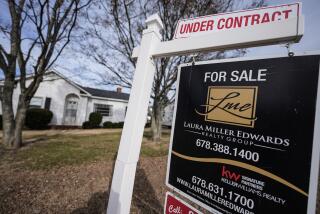Housing Suddenly a Buyer’s Market
- Share via
Most of America’s residential real estate complexion changed abruptly in the past 60 days from a long-term seller’s market to one in which the buyer now holds the upper hand in bargaining on price and concessions related to the sale of either a new or an existing home.
This is especially true in the market of houses priced over $150,000. And most of them now seem to be in that once ridiculously high price category.
The median price of an existing house in the metro Washington area increased nearly 25% in the past year to $132,400. Figures from the National Assn. of Realtors also showed that the average house price hereabouts increased about $11,000 in the first quarter of 1988. The national median and average price increases were somewhat less but still significant.
An informal survey of area sellers of new and existing houses showed, in early June, that almost all houses are now difficult to move. “It just seems that all of that pent-up demand for housing has been exhausted,” said realtor Earl Farr. Sales agent Judy Lightman added that the slight upward trend in mortgage rates has not been sufficient to turn off really serious buyers, but she acknowledged that few sales contracts are being signed these days and added: “We’d all like to know just why.”
Joseph C. Murray, who has followed the metro housing market here for 30 years, said, “There’s probably no simple explanation for the downturn in residential sales, but I suspect it has a lot to do with the high level of sales over the past six years and the accompanying--nearly 100% across the board here--rise in the prices of both new and resale houses since the housing depression of 1981.”
Not unlike other seasoned brokers and sales executives in this area, Murray interprets the cooling off in sales to the disappearance of any residual, unsatisfied demand for housing by qualified buyers and the potential buyer turnoff produced by an unbelievably high level of current asking prices in a period when mortgage rates have inched up about one full percentage point since March, when sales were very strong.
Realtor associate Edison Kipp suggested that the abrupt transformation from a seller’s to a buyer’s market in residential real estate occurred mainly because a lot of “discretionary” purchasers made up their minds to stop looking. Kipp explained that any upward spiral in prices usually encourages some homeowners to consider “moving up” to take advantage of the additional paper value in their own houses.
“When you live in a house that you bought for $85,000 eight years ago and a similar house next door sells for $155,000, you think about selling and going for something bigger in a more desirable neighborhood. But when you find out that offers are scant for your house listed at $160,000, and that you are not satisfied with a next house priced less than $260,000--you begin to have second thoughts.”
Sales executive Ariff Kassim, noting that hot sales in April cooled off perceptibly in May at his new-home project, added a trenchant personal comment:
“My family and I live in a nice home in a nice neighborhood in a suburban area just 12 miles northwest of the White House. We like the house, but like many other folks, we’d like to have a large family room instead of a den, plus a more modern kitchen and bathroom. Nothing really fancy, just a modest move upward. We learned quickly that we have to increase our mortgage by nearly $100,000 to make that move. That would cost us about $1,000 more each month. So we’re staying put for awhile.”
Apparently, that’s the attitude being taken by many other discretionary buyers--those who do not have to buy a home now. They’ve decided to wait a spell. Meanwhile, now buyers can bargain on prices instead of bidding higher to get the house they want.
If this now desultory residential real estate market continues through summer, you could see both asking prices and mortgage rates come down again--and, almost magically, there will again be more potential buyers than there are dwellings being marketed.
More to Read
Inside the business of entertainment
The Wide Shot brings you news, analysis and insights on everything from streaming wars to production — and what it all means for the future.
You may occasionally receive promotional content from the Los Angeles Times.









